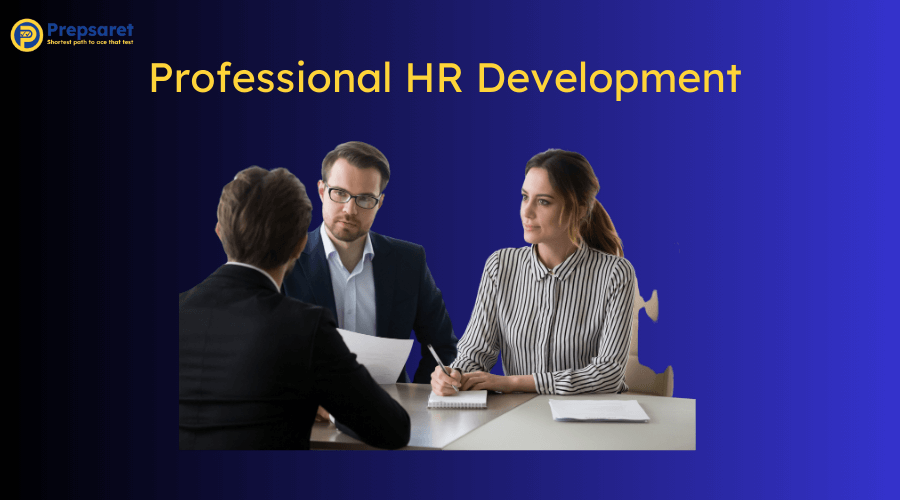Professional HR Development
In today’s fast-paced business world, staying ahead of the curve is essential for both organizations and HR professionals. One of the most effective ways to do so is through professional HR development.
This ongoing process helps HR professionals build and refine their skills to adapt to industry changes, boost their leadership capabilities, and drive organizational success.
Whether through professional HR development courses or HR training and development courses, continuous learning is crucial.
More than just helping HR professionals advance in their careers, HR development plays a critical role in enhancing employee growth and engagement.
By incorporating HR training topics for employees into workplace learning initiatives, organizations can ensure a well-rounded, high-performing workforce.
In this article, we’ll explore the importance of HR development, SHRM competencies, and how to create a successful HR development program that aligns with corporate HR development strategies.
The Importance of Professional HR Development in Modern Organizations
Why is professional HR development so important? With the workplace constantly evolving, HR professionals must continuously refine their knowledge and skills to stay relevant.
By investing in HR professional development, organizations not only improve employee satisfaction but also boost retention rates and overall performance.
Skilled HR professionals who have pursued professional HR development certification are better equipped to create effective strategies for talent management, employee engagement, and leadership development.
Additionally, providing human resources development training ensures that HR teams stay updated on best practices and compliance regulations, strengthening organizational success.
Key SHRM Competencies for Effective HR Development
To succeed in HR professional development, it’s crucial for professionals to master a set of core competencies. The Society for Human Resource Management (SHRM) identifies several key competencies that help HR professionals excel:
- Relationship Management: Building and maintaining strong, positive relationships with employees, leadership, and other stakeholders.
- Consultation: Providing expert advice and guidance to leadership and teams to solve organizational challenges.
- Global & Cultural Effectiveness: Understanding and managing diverse teams in today’s multicultural work environments.
- Communication: Effectively communicating with all levels of an organization, from employees to executives.
- Critical Evaluation: Using data to assess organizational needs and make informed decisions.
Mastering these competencies equips HR professionals with the tools they need to drive success in their roles and advance their careers.
Those who complete HR training and development courses gain a deeper understanding of these competencies and how to apply them in real-world scenarios.
Learn: What Happens after You Pass SHRM
Integrating SHRM’s Competency Model into HR Development Programs
HR professionals can significantly enhance their HR development programs by integrating SHRM’s competency model.
This model outlines the necessary skills and behaviors that HR professionals should master to be effective in their roles. By using this framework, HR leaders can create structured HR training topics for employees that focus on the most critical competencies.
For example, an HR professional development initiative may include best HR training programs with workshops or training sessions tailored to improving relationship management or critical evaluation skills.
These programs can be customized to meet organizational needs, whether it’s enhancing leadership effectiveness or improving communication within teams.
By aligning HR training and development courses with SHRM’s competency model, organizations create a structured approach to workforce development that ensures continuous improvement in HR practices.
How to Build a Robust HR Development Strategy
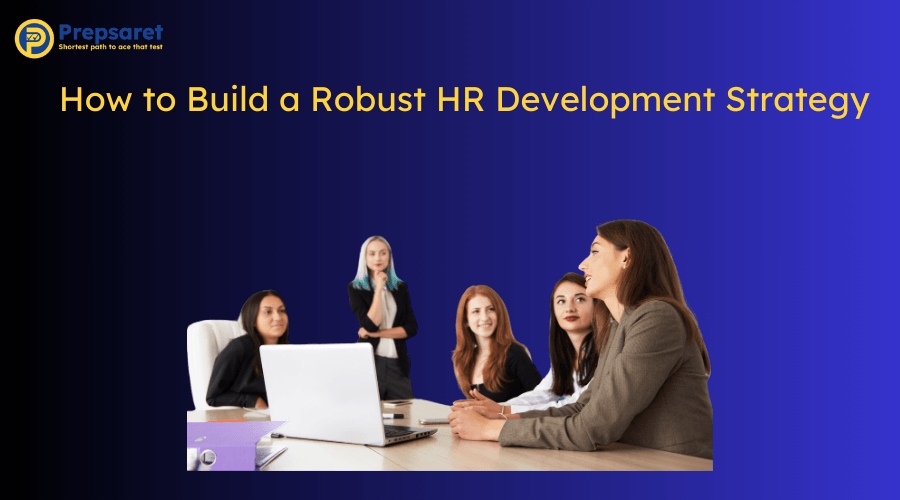
Creating an effective HR development strategy requires careful planning, alignment with organizational goals, and a focus on professional development topics for employees. Here’s a roadmap to help you build a comprehensive strategy:
- Understand Organizational Needs: Start by assessing your organization’s goals and challenges. What skills are necessary for the future success of your company? Align your corporate HR development strategies with these needs.
- Focus on Employee Growth: A successful strategy emphasizes both employee development and long-term organizational success. Identify HR training topics for employees that enhance skills in leadership, communication, and problem-solving.
- Incorporate SHRM Competencies: Use SHRM’s competency model to guide HR training and development courses, ensuring that they cover the essential areas that contribute to effective HR practices.
- Offer Ongoing Learning Opportunities: Provide continuous learning through professional HR development courses, online resources, and human resources development training.
- Measure Success: Regularly evaluate the effectiveness of HR development programs. Track progress, collect feedback, and make necessary adjustments to ensure continuous improvement.
By following this roadmap, you’ll create a strategy that not only supports HR professional development but also fosters a culture of continuous learning.
Organizations that prioritize professional HR development jobs and structured training programs build a stronger, more adaptable workforce.
HR Development Best Practices: Elevating Employee Engagement and Performance
In today’s fast-paced workplace, employee engagement and performance are more critical than ever. But how can HR teams ensure that employees are motivated, developing their skills, and performing at their best? Implementing the right corporate HR development strategies is key.
By focusing on leadership development, offering HR training and development courses, and fostering a culture of feedback, HR departments create an environment where employees and organizations thrive.
Developing Leadership Skills through HR Training and Development
One of the most impactful ways to elevate engagement is by developing leadership skills. Best HR training programs include leadership development initiatives that make a real difference in how employees view their roles and the company’s future.
These programs don’t just benefit future leaders—they create a positive impact across the entire organization. Integrating leadership development into HR professional development efforts ensures that employees feel valued and supported in their careers.
When employees see that their organization invests in professional HR development courses, they are more likely to be engaged and committed to their roles. These programs often cover professional development topics for employees such as communication, decision-making, and conflict resolution.
Investing in professional HR development is not just about individual career growth—it’s about strengthening the entire organization.
By implementing human resources development training, organizations ensure their HR teams are equipped to lead, innovate, and adapt to an ever-changing business environment.
Whether through HR training topics for employees, professional HR development certification, or structured HR development programs, continuous learning is essential.
By embracing corporate HR development strategies, organizations build a resilient, high-performing workforce ready to tackle future challenges.
Aligning HR Development with Organizational Goals and Culture
It’s easy to assume that HR development for organizations is just about personal growth and HR skill development. However, it’s essential that HR training and development best practices are aligned with the overall business strategy and the organization’s values.
When HR development programs for employees are tied to the company’s mission and goals, they have a greater impact on both individual and organizational success.
Tailoring workplace HR development to align with organizational goals ensures that employees are working toward the same objectives. It also helps reinforce the company’s culture and values, making sure everyone is on the same page.
For example, if a company values innovation, HR leadership development should focus on fostering creativity and providing opportunities for employees to think outside the box.
This alignment between employee development in HR and business strategy also leads to a more motivated workforce. Employees who understand how their growth contributes to the company’s success are more likely to stay engaged and committed.
By ensuring that HR employee engagement and development is woven into the fabric of the organization’s culture, companies can create a unified team that works toward common objectives.
Related post: Why Employers Prefer Candidates with SHRM Certifications
Leveraging Technology for HR Development and Growth
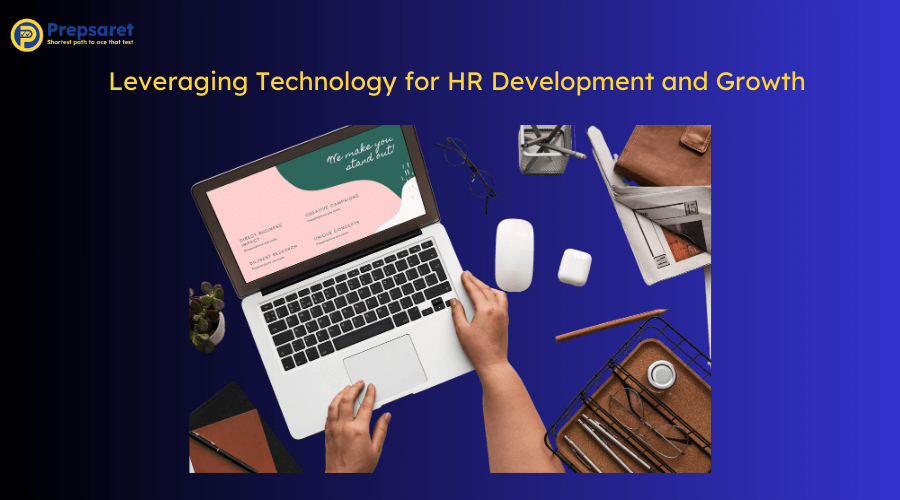
Technology is revolutionizing human resources learning and development, making it easier to offer personalized, efficient, and engaging HR talent development programs. Today’s HR departments can use a variety of tech tools to enhance their efforts and improve employee engagement.
From HR development resources such as learning management systems (LMS) to online training courses, technology provides countless opportunities for organizations to expand their HR career development initiatives.
With virtual training sessions, employees can access materials and courses anytime, anywhere, ensuring that learning doesn’t have to stop when the workday ends.
Technology also allows for data-driven insights into employee progress, helping HR departments better understand which effective HR development strategies are working and which need improvement.
Tools like employee engagement software can help HR teams measure satisfaction and performance, allowing for adjustments to be made in real-time.
But the benefits don’t stop at efficiency. By integrating technology into advanced HR development techniques, organizations can offer more personalized experiences for employees, ensuring that each individual receives the support and training they need to succeed.
Tech solutions make HR development for organizations more flexible, scalable, and, most importantly, effective.
Continuous Learning in HR: Key to Career Advancement
The HR field is constantly evolving, which means HR professionals need to be committed to professional development for HR managers. Staying up to date with the latest trends, tools, and best practices is crucial to remaining competitive and advancing in your career.
Whether it’s through formal education, attending industry conferences, or taking advantage of online courses, continuous learning allows HR professionals to acquire new skills and expand their knowledge base.
This commitment to growth doesn’t just benefit the individual—it also helps organizations stay innovative and agile in a rapidly changing business environment.
For employees, a culture of continuous learning is a huge motivator. When HR departments provide opportunities for HR skill development, employees are more likely to stay engaged and excited about their roles.
Additionally, learning opportunities are essential for career advancement, as employees who continue to grow are better equipped to take on leadership positions and new challenges.
HR departments that prioritize human resources learning and development create a culture of growth that benefits both the individual and the organization.
Employees who feel supported in their HR career development are more likely to stay engaged, perform at their best, and contribute to the company’s success.
Check this out: SHRM-CP Test Prep
Building a Diverse Talent Pool with HR Development Initiatives
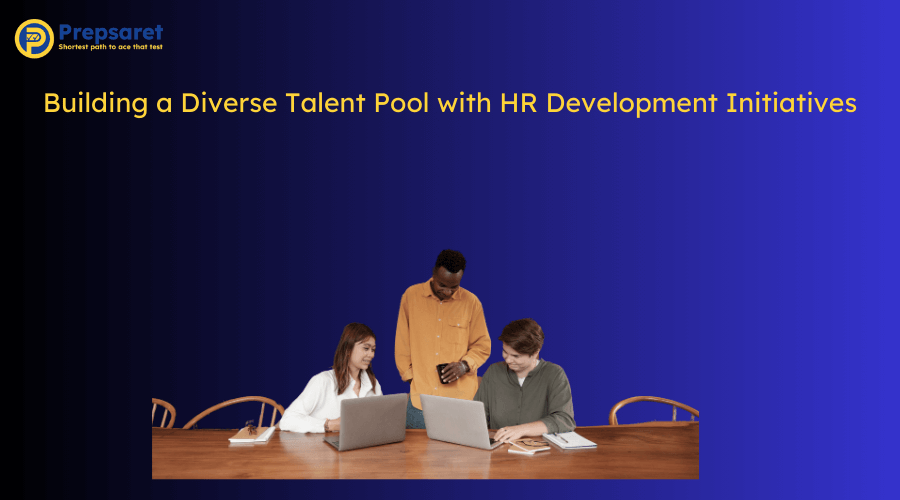
When it comes to creating a diverse talent pool, HR development programs for employees are your best friend. They’re not just about ticking boxes—they’re about building a workplace where everyone, regardless of their background, feels like they belong. Here’s how HR talent development programs can promote diversity, equity, and inclusion (DEI):
- Attracting Talent from Diverse Backgrounds: DEI-focused HR leadership development initiatives help attract a wide range of candidates, ensuring that your recruitment efforts are not limited by bias. The more inclusive your recruitment strategies, the more varied and talented your pool will be.
- Retention is Key: It’s not enough to hire diverse talent. You need to keep it! A diverse, inclusive culture leads to better retention rates, as employees are more likely to stay when they feel supported and valued for their unique perspectives.
- Promoting Innovation and Success: When employees from different backgrounds work together, they bring unique solutions to the table. This diversity fosters creativity and drives innovation, leading to stronger outcomes for the business.
- Building Stronger Connections with Clients: A workforce that mirrors the diversity of your customers or clients will better understand their needs, creating more meaningful relationships and boosting client satisfaction.
In the long run, promoting DEI through effective HR development strategies not only builds a positive organizational culture but also drives success by attracting and retaining top talent from a variety of backgrounds.
Read on: Careers for SHRM Certified Professionals
Measuring the Impact of HR Development on Organizational Success
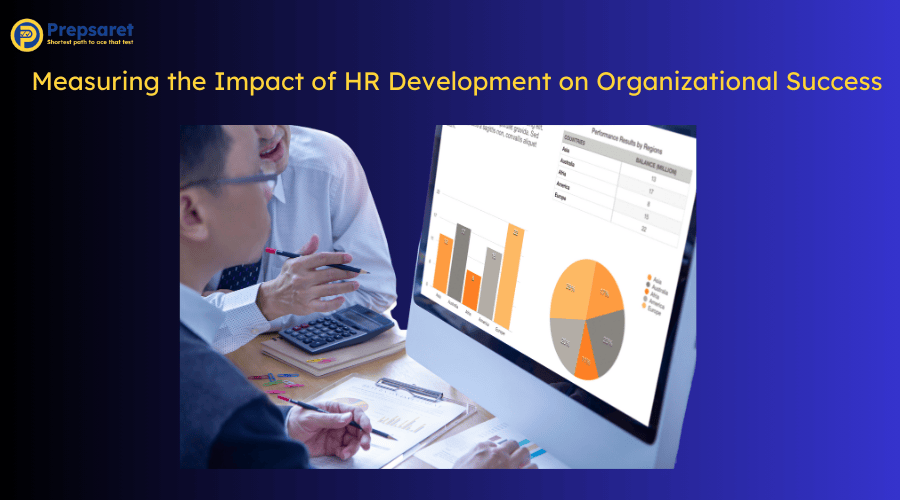
Measuring the impact of HR training and development best practices is essential for understanding their effectiveness. Here’s how HR professionals can assess whether these programs are delivering real results:
- Employee Engagement: Tracking engagement scores before and after HR development programs for employees can reveal whether employees are feeling more motivated and connected to the organization.
- Internal Promotions and Career Growth: If HR career development programs are successful, HR should see an increase in internal promotions, which indicates that employees are progressing within the organization.
- Employee Retention Rates: A well-executed HR leadership development program leads to higher employee satisfaction and, in turn, reduces turnover.
- Productivity and Efficiency: By tracking performance metrics, HR can gauge whether HR talent development programs are translating into higher productivity, better teamwork, and more effective problem-solving.
Aligning HR employee engagement and development with organizational goals is the secret to measuring success. When workplace HR development supports both employee growth and business growth, the results speak for themselves.
Using Data-Driven Approaches for HR Development Decision-Making
In today’s world, HR development resources are more effective when they’re backed by data. Here’s how HR can use data-driven approaches to optimize their HR training and development best practices:
Key Metrics to Track
- Employee Performance: Metrics like productivity and individual KPIs can show how well employees are growing and meeting goals.
- Turnover Rates: High turnover could indicate that HR development strategies aren’t meeting employee needs or expectations.
- Engagement Levels: Surveys and feedback help HR teams measure how connected employees feel to their work and the company.
Making Informed Decisions
Data helps HR professionals identify which HR skill development programs are working and which aren’t. For example, if employees aren’t progressing as expected, HR can adjust the content or delivery of HR leadership development programs.
Continuous Improvement
Data-driven insights allow HR teams to continuously refine HR development for organizations, ensuring that they’re always in line with employee needs and business objectives.
With a data-driven approach, HR can make decisions that directly impact the success of both employees and the organization, creating a win-win scenario for everyone.
By using these advanced HR development techniques, organizations can not only build a more diverse and talented workforce but also create a culture of growth and opportunity.
Embracing DEI, using data to inform decisions, and measuring success are all crucial steps in ensuring that HR development programs for employees lead to long-term organizational success.
FAQs
What Does HR Development Do?
Human Resource Development (HRD) focuses on enhancing employee skills, knowledge, and competencies to meet organizational goals. It encompasses training programs, career development initiatives, and performance management strategies.
HRD aims to empower employees, fostering motivation and productivity while aligning individual aspirations with company objectives.
By investing in employee growth, organizations can create a skilled workforce capable of adapting to changing business environments and driving overall success.
What is HR Performance Development?
HR Performance Development is a continuous process aimed at enhancing employee skills, knowledge, and overall work performance. It involves ongoing communication between managers and employees to clarify responsibilities and set future goals.
Unlike performance management, which often focuses on past evaluations, performance development emphasizes proactive strategies for improvement and growth.
This collaborative approach fosters accountability, encourages feedback, and aligns individual objectives with organizational goals, ultimately driving employee engagement and effectiveness.
What are HRD Professionals?
Human Resource Development (HRD) professionals focus on enhancing employee skills and capabilities to align with organizational goals. Their responsibilities include assessing training needs, designing development programs, and implementing continuous learning initiatives.
HRD aims to foster a culture of growth, ensuring employees are equipped for current and future challenges.
By nurturing talent internally, HRD professionals contribute to increased employee engagement, retention, and overall organizational effectiveness, ultimately driving business success.
How Do I Develop Myself as an HR Professional?
To develop yourself as an HR professional, focus on continuous learning and skill enhancement. Identify your strengths and align them with your career aspirations.
Set SMART goals to address skills gaps and pursue relevant training opportunities, such as certifications or workshops. Engage in networking through professional associations to broaden your knowledge and connections.
Additionally, seek mentorship and participate in job rotation to gain diverse experiences within the HR field.
What is an Example of a Development Goal for HR?
A notable development goal for Human Resources (HR) is to increase employee engagement scores by 10% by the end of 2024.
This goal is specific, measurable, achievable, relevant, and time-bound (SMART).
To achieve this, HR can implement regular feedback mechanisms, recognition programs, and professional development opportunities, which enhance overall employee satisfaction and morale, ultimately leading to improved productivity and reduced turnover rates.

